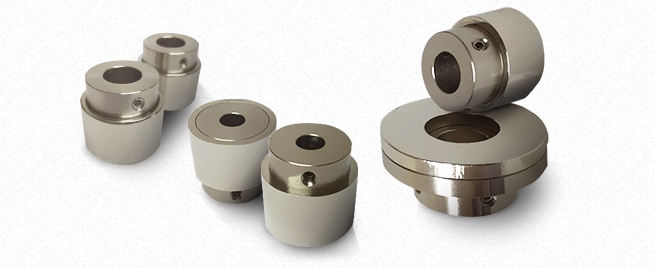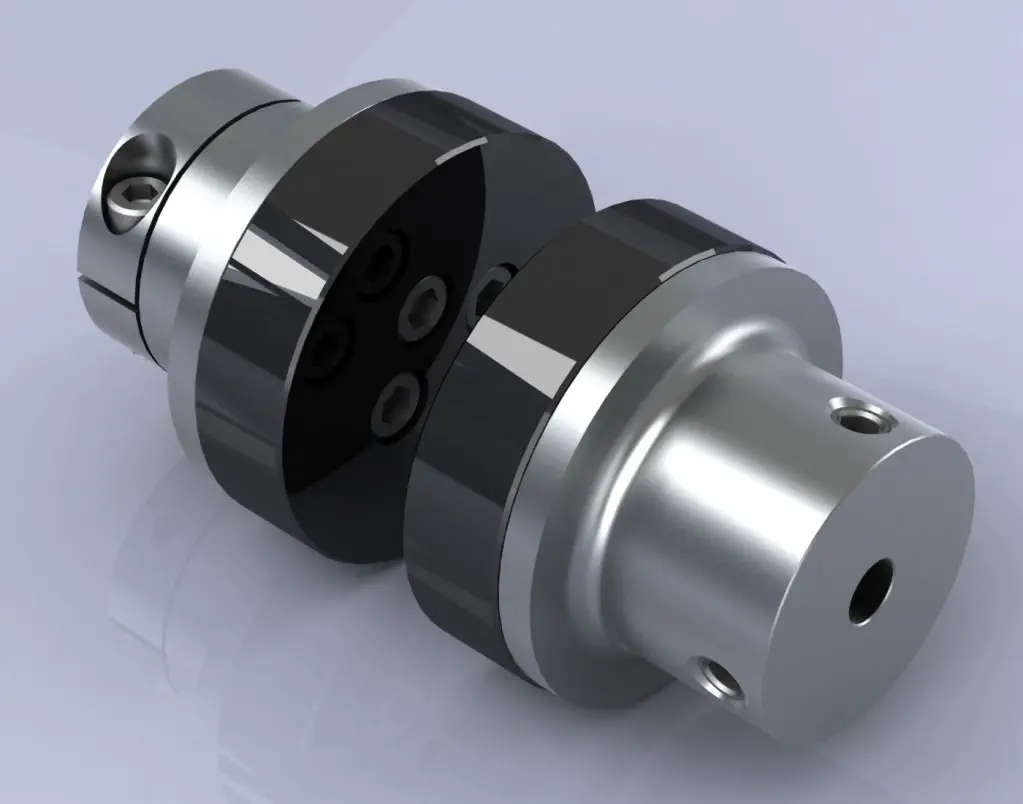Product Description
Made in China custom Magnetic Coupling with High Quality
Introducing our custom Magnetic Coupling, proudly made in China with the highest quality standards. This coupling is designed to provide exceptional performance and reliability, making it an ideal choice for various applications.
Our Magnetic Coupling is crafted using rare earth magnets, ensuring a strong and durable connection. It offers a secure and efficient transfer of power between shafts, eliminating the need for physical contact. This feature not only reduces wear and tear but also minimizes the risk of contamination, making it suitable for sensitive environments.
Ordinary magnetic coupling, working temperature less than 80 ºC, without acid or alkali corrosion environment. Please contact customer service for customization.
| NO. | ФA | ФB | C | ФD | Фa | Фb | Фd | E | F | H | J | K | L | M | P | S | T | V | Фh | Фx | torqueN.m |
| YCL045 | 45 | 38 | 50 | 19 | 33 | 27 | 12 | 32 | 6 | 38 | 5 | 4 | 60 | 4 | 3 | 2 | 5 | 39 | 31 | 65 | 2 |
| YCL060 | 60 | 47 | 58 | 24 | 43 | 35 | 15 | 38 | 8 | 46 | 6 | 5 | 70 | 5 | 4 | 2 | 6 | 48 | 40 | 90 | 6 |
| YCL080 | 80 | 58 | 65 | 28 | 58 | 48 | 20 | 40 | 8 | 50 | 7 | 6 | 80 | 6 | 5 | 4 | 8 | 51 | 55 | 115 | 12 |
| YCL100 | 100 | 70 | 100 | 35 | 72 | 58 | 25 | 72 | 10 | 83 | 8.5 | 7 | 117 | 8 | 6 | 6 | 10 | 84 | 68 | 142 | 45 |
| YCL120 | 120 | 70 | 105 | 35 | 86 | 70 | 30 | 72 | 10 | 86 | 8.5 | 7 | 125 | 8 | 8 | 8 | 10 | 88 | 82 | 165 | 84 |
If customization is required, please contact customer service
/* January 22, 2571 19:08:37 */!function(){function s(e,r){var a,o={};try{e&&e.split(“,”).forEach(function(e,t){e&&(a=e.match(/(.*?):(.*)$/))&&1

Torque and Speed Limitations of Magnetic Couplings for Different Sizes and Applications
The torque and speed limitations of magnetic couplings depend on various factors, including the size of the coupling and the specific application requirements. Here’s a general overview of these limitations:
- Torque Limitations:
The torque capacity of a magnetic coupling is influenced by the strength of the magnets used, the size of the coupling, and the materials chosen for the rotor and containment shell. Larger magnetic couplings with stronger magnets and robust materials can handle higher torque requirements.
- Size and Application:
The size of the magnetic coupling plays a crucial role in determining its torque capacity. Smaller couplings are typically used in low-torque applications, such as laboratory equipment or small pumps. In contrast, larger couplings can handle higher torque demands, making them suitable for industrial-scale pumps and agitators.
- Speed Limitations:
The maximum speed at which a magnetic coupling can operate depends on several factors, including the rotational speed of the driving and driven shafts and the design of the coupling. High-speed applications, such as centrifugal pumps, require magnetic couplings designed to minimize eddy current losses and ensure stable performance at elevated speeds.
- Specialized Applications:
Some magnetic couplings are specifically designed for high-speed or high-torque applications, such as in large industrial pumps or agitators. These specialized couplings are engineered with materials and construction techniques to optimize performance under demanding conditions.
- Customization Options:
Manufacturers of magnetic couplings may offer customization options to tailor the torque and speed ratings to the specific needs of the application. This can involve selecting different magnet configurations, materials, and overall design adjustments to achieve the desired performance characteristics.
It is essential to consult with the coupling manufacturer or a qualified engineer to determine the appropriate magnetic coupling size, torque, and speed ratings for a specific application. Factors such as the fluid properties, load requirements, and environmental conditions should be taken into account to ensure the coupling’s optimal performance and reliability.

How do Magnetic Couplings Contribute to the Overall System Reliability and Prevent Mechanical Wear?
Magnetic couplings offer several advantages that contribute to the overall system reliability and prevent mechanical wear. These benefits are a result of their non-contact power transmission principle and unique design features. Here’s how magnetic couplings achieve this:
- No Physical Contact:
Magnetic couplings operate without any physical contact between the driving and driven components. Unlike traditional mechanical couplings that rely on friction and wear-prone components, magnetic couplings use magnetic fields to transfer torque and power. This absence of physical contact eliminates mechanical wear and reduces the need for regular maintenance and replacement of wearing parts.
- Hermetic Sealing:
Magnetic couplings often feature a hermetic sealing design that prevents fluid leakage. The driving and driven components are separated by a sealed containment shell, which ensures that there is no direct exposure to the environment or the fluid being handled. This hermetic sealing not only prevents leakage but also protects sensitive components from contamination and external influences, enhancing the overall system reliability.
- Reduced Friction Losses:
Since there is no physical contact between the coupling’s components, magnetic couplings experience minimal friction losses during operation. The reduction in frictional forces translates to higher efficiency and lower energy consumption compared to traditional couplings with sliding or rolling elements.
- Tolerance to Misalignment:
Magnetic couplings can accommodate a certain degree of misalignment between the driving and driven components. This misalignment tolerance helps to minimize stress on the coupling and connected equipment, reducing the risk of premature wear or failure in situations where perfect alignment may not be achievable or maintained over time.
- Overload Protection:
Some magnetic couplings are designed with built-in overload protection features. In case of excessive torque or sudden overloads, these couplings can disengage or slip, preventing damage to the coupling and the connected machinery. This overload protection contributes to the long-term reliability of the system by avoiding potential catastrophic failures.
- No Lubrication Required:
Unlike many traditional mechanical couplings that need regular lubrication to reduce friction and wear, magnetic couplings do not require lubrication. The absence of lubricants simplifies maintenance and eliminates the risk of lubricant contamination in sensitive applications.
Overall, magnetic couplings offer a reliable and efficient solution for various applications, especially in industries where the prevention of mechanical wear, fluid leakage, and frequent maintenance are essential considerations. Their non-contact design, hermetic sealing, and tolerance to misalignment make them an attractive choice for critical systems that demand high reliability and performance.

Working Principle of a Magnetic Coupling and Its Advantages Over Traditional Couplings
A magnetic coupling operates on the principle of magnetism to transmit torque from one shaft to another without direct physical contact. It consists of two rotors, an outer rotor connected to the driving shaft and an inner rotor connected to the driven shaft, with a containment shell separating them.
Here’s how a magnetic coupling works:
- Permanent Magnets:
Both the outer and inner rotors contain permanent magnets with alternating poles facing each other. When the driving shaft rotates, the magnets on the outer rotor create a magnetic field.
- Magnetic Induction:
This magnetic field induces a corresponding magnetic field in the inner rotor due to the magnetic permeability of the containment shell. As a result, the inner rotor starts to rotate synchronously with the outer rotor.
- Torque Transmission:
The interaction between the magnetic fields allows torque to be transferred from the driving shaft to the driven shaft without any physical connection. The two shafts remain completely isolated from each other.
The advantages of magnetic couplings over traditional couplings include:
- No Physical Contact:
Magnetic couplings offer non-contact power transmission, eliminating wear and friction that can occur in mechanical couplings. This results in longer service life and reduced maintenance requirements.
- Misalignment Compensation:
Magnetic couplings can tolerate a certain degree of misalignment between the driving and driven shafts. This ability to compensate for misalignment reduces stress on the components and enhances system reliability.
- Hermetic Sealing:
The containment shell in a magnetic coupling provides hermetic sealing between the input and output shafts. This prevents fluid leakage, making magnetic couplings suitable for applications involving hazardous or sensitive fluids.
- Overload Protection:
In case of sudden overloads or blockages in the driven system, a magnetic coupling can slip or disengage, protecting the driving motor and connected components from damage.
- No Lubrication Required:
Since there is no physical contact between components, magnetic couplings do not require lubrication. This feature simplifies maintenance and avoids potential fluid contamination.
Magnetic couplings find applications in various industries, including chemical processing, food and beverage, pharmaceuticals, and power generation, where these advantages are essential for efficient and reliable power transmission.


editor by CX 2024-05-07